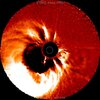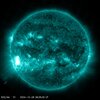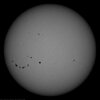NBAcentel
Member
Those regions on the farside of the sun are producing full halo CMEs and look large on farside imagery. They will be back next week 



000111011100101I thought Sandbar would be all over this thread.
I thought Fro would be in here as wellI thought Sandbar would be all over this thread.
STRONG SOLAR ACTIVITY RESUMES: The quiet has broken. Today sunspot 3936 produced a strong X1-class solar flare (0717 UT) along with a series of M-class flares peaking at M7 (1509 UT). As a result of these explosions, at least one CME is heading for Earth, and a NASA model shows it reaching Earth late on Dec. 31st. " solarham.com "A partial halo CME observed leaving the Sun earlier on Sunday (Dec 29) is predicted to sweep past Earth by New Years Eve (Dec 31). A strong (G3) geomagnetic storm watch was officially added by NOAA/SWPC for that date. Contrary to other sources, the CME is not related to the X-Flare and was the result of an eruption in the vicinity of AR 3939 in the southeast quadrant. Perhaps some aurora to ring in the new year should local weather and viewing conditions allow." Late Dec 31 would be 24z or 6pm central time. It would be great to see the Northern Lights before the fireworks! |
What does that mean?Tight delta sunspot on region 3981 in the southern middle spot with a lot of other spots getting strong magnetic shear, oh boy View attachment 167580View attachment 167581
Sorta similar to a radar couplet, lots of magnetic shear packed in one tight spot, delta sunspots are volatile and can produce significant solar flares and associated coronal mass ejections. The tighter the blue and red is, the more likely you got a delta sunspot with 2 or more spots within a penumbra. Think of a delta as a constant aggravation with 2 opposing magnetic fields pushing up on each other creating instability and increases the odds for something to go boomWhat does that mean?
What this mean? Enhance views of what?? Thanks!This looks promising if it can hold into tonight, nearing the equinox so the russel McPherson effect may enhance views, if we can maintain consistent southward pointed fields could be some views in the upper SE tonight. Need the -BZ to hold
Brief Red hues of aurora in the northern sky. But that’s only if solar wind parameters maintain until tonightWhat this mean? Enhance views of what?? Thanks!
How the heck do you know so much?! It's truly astonishingThis looks promising if it can hold into tonight, nearing the equinox so the russel McPherson effect may enhance views, if we can maintain consistent southward pointed fields could be some views in the upper SE tonight. Need the -BZ to hold View attachment 171286View attachment 171287
That May Gannon G5 storm really got me into it, just went to some space wx forums and learned quite honestly from the guys that know a lot, didn’t ask to much questions, just saw posts and what could be good for Aurora events and bad for itHow the heck do you know so much?! It's truly astonishing
Forums really do teach a lot , I used to be in the space weather forums except it was more of a global cooling conspiracy forum where we tracked sunspots and solar max intensities to predict cycles of cooling lolThat May Gannon G5 storm really got me into it, just went to some space wx forums and learned quite honestly from the guys that know a lot, didn’t ask to much questions, just saw posts and what could be good for Aurora events and bad for it
Probably lower MN, would be my guess. But there is smoke in the air, so that may make it difficult to see.Looks like a G3 tonight. Curious how far South it will be visible.
Seems like it might have been something else. Geomagnetic Storm conditions have been nominal.Did anyone else see northern lights earlier tonight? Didn’t see any news about it. But was out on my porch mid evening tonight and thought I saw something. My camera definitely saw a pink glow. I’m just NW of Atlanta. Anyone else see anything?

